
Tracking calories is one of the most effective ways to manage weight. But if you've tried calorie counting before, you know it isn't as simple as it sounds. Starting can feel overwhelming, especially when you have to figure out how to use a tracking app like MyFitnessPal. You might not even know what your goals are yet. Finding the right MyFitnessPal alternative can help you hit the ground running with your weight management journey. So, But, How Are Calories Measured? This article will introduce you to a better calorie counter that makes it easy to track food and fitness to achieve your health goals.
Cal AI's calorie tracker solution is valuable for reaching your objectives and simplifying tracking your food and fitness. With its easy-to-use interface and personalised features, it takes the hassle out of calorie counting so you can focus on what matters most: your health.
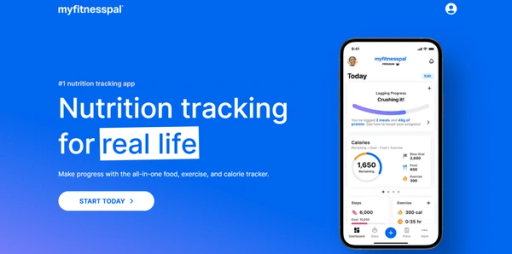
MyFitnessPal is a popular food-tracking app that helps you log your daily food intake and exercise to reach your fitness goals. The app is robust and user-friendly enough that we use it with all our vegan online coaching clients. It has its downsides (as you’ll soon see, and as any app does), but it’s a great tool to figure out where you’re at nutritionally.
MyFitnessPal is a great place to start for anyone new to tracking their food intake. The app has an intuitive interface, and you can start without much of a learning curve.
MyFitnessPal boasts a database of almost 14 million food items—including the weird vegan ones most non-vegans have never heard of! You can even scan the barcodes of most food packages, and the app will automatically load those foods.
Note: This is also a "con," as the barcode scanner was recently put behind a paywall!
You can create precise recipes and save them for later use, so you don’t have to input each ingredient separately whenever you eat that food. You can also copy and paste entire meals to previous or future days.
You don’t need to carry a kitchen scale and weigh every ingredient you eat. I use easy measurements for my food logs, like cups, tablespoons, and litres when inputting my foods, which are much easier to eyeball than grams.
You have options regarding the measurements to use, including:
Most often, MyFitnessPal grossly underestimates its users’ calorie requirements. It doesn’t take nearly enough variables into account. For example, it tells me I should eat 2000 calories per day to maintain my weight, which is over 3000.
The calorie goal you get from the app doesn’t include exercise, but there’s no way I’m burning 1000 calories per day working out (see #3 below about accounting for exercise).
Check out this screenshot. Even though I’ve manually adjusted my daily calorie goal to my actual maintenance level (3000+), not what MyFitnessPal thinks it is (2000), it still uses its original extremely low calorie number to spout BS like this. I’ve weighed 125 pounds for at least 10 years. There’s no way I’ll gain 17.5 pounds in 5 weeks by eating as I usually do! This type of notification could be helpful for people trying to shed fat. Still, if you can’t tell the app to use your much more accurate calorie goal for this calculation, it’ll always be wildly inaccurate. We tell our clients to ignore this screen whenever they see it.
Keep in mind that the calorie goal you get from the app does not account for exercise. If you exercise, those are “extra” calories you can consume on top of your baseline.
Using my baseline (suggested by the app) of 2000 calories, if I were to expend 300 calories doing some strength training, my total “available” calories for that day would increase to 2300.
Estimating calorie expenditure from exercise is likely even more of a guessing game than estimating daily calorie needs. The app doesn't take into account countless essential variables.
So, we tell our clients to manually enter their daily calorie goal from this calculator, which includes exercise, and then not input their exercise into MyFitnessPal (we use a different app to track workouts and fitness progress).
The MyFitnessPal app's food database is primarily user-generated. The app puts a green checkmark symbol next to foods it thinks have complete and accurate nutrition information, but these could still contain inaccuracies.
This serves as another reminder that food logging isn’t meant to be 100 percent exact. In Part 4 of this series, you can take a look at some of my food logging and see what an active vegan who kicks other people’s asses for a living eats in a day.
Starting in 2022, MyFitnessPal put the barcode scanner, one of the app's most valuable features, behind a paywall.
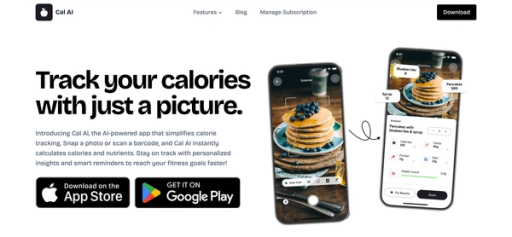
Calorie tracking can be tedious, especially if you do it manually. Fortunately, Cal AI is a revolutionary app that transforms calorie tracking with cutting-edge AI technology. Just snap a photo of your meal, and Cal AI does the rest. Cal AI combines your phone's depth sensor with advanced AI models to:
With 90 percent accuracy on visible foods and multiple tracking options, Cal AI makes nutrition tracking effortless. Gone are the days of tedious manual logging in calorie tracking apps. Whether scanning a full meal or a quick snack, Cal AI gives you accurate nutritional information in under 15 seconds.
The AI learns from your feedback, continuously improving its accuracy. Stay on track with personalized insights and brilliant reminders. Cal AI simplifies achieving your fitness goals. Track your calories with your camera using Cal AI's calorie tracker.
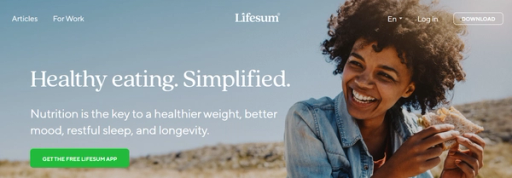
One of the most popular diet and exercise tracking alternatives to MyFitnessPal is Lifesum. The app has tried to move away from labels such as “calorie counter” and “diet app” and instead markets itself as a “digital self-care app.” Lifesum’s interface is colorful and quirky, making it a hit with fitness influencers and popular with a modern audience.
You can create your custom profile, set dietary goals, choose nutritional preferences, and get started on a hassle-free meal plan in just a few clicks. The app has a vast food database featuring millions of food items, plus a built-in barcode scanner to make updating your food diary easier.
If you’re trying to use an app to drink more water or increase your fruit and vegetable intake, then Lifesum’s habit trackers can help you build lasting, healthy habits. The basic version of Lifesum, including a barcode scanning feature, is free to use, but you must pay a small monthly subscription to access all its features.
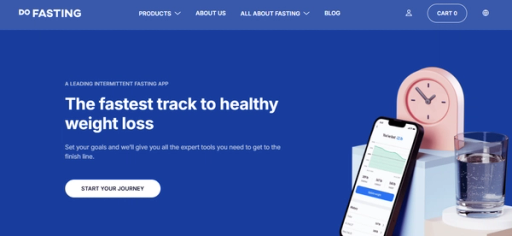
At its core, DoFasting is a comprehensive platform aimed at individuals seeking to reap the benefits of intermittent fasting.
This app provides users various fasting plans tailored to different preferences and needs, from the popular 16:8 method to advanced 5:2 fasting. Because of its wide range of plans, this app suits both beginners and experienced intermittent fasters.
Upon using DoFasting, individuals can access several helpful and intuitive tools. Key features include personalized fasting schedules, progress tracking, over 5,000 recipes, and water intake reminders, ensuring users remain on track with their goals.
This app shares similarities to MyFitnessPal, including its:
DoFasting excels MyFitnessPal, providing helpful intermittent fasting support, including personalized fasting schedules and reminders.
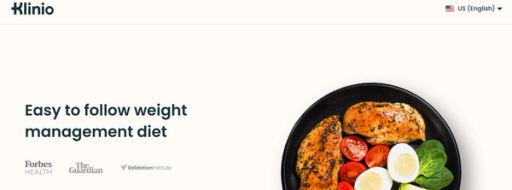
Klinio is a MyFitnessPal alternative created for anyone living with diabetes. Weight management is one of the most critical factors in reducing cardiovascular disease and comorbidities related to type 2 diabetes. Losing weight after a diabetes diagnosis is more challenging since the body develops insulin resistance, converting sugar into fat instead of fuel.
Along with using a food diary, personalized meal plan, and detailed progress tracker for weight loss, Klinio focuses on reducing HbA1c, directly impacting the need for diabetes-related prescriptions.
The included home workouts and activity logs can benefit anyone looking for a weight loss app, while the educational content offers extra support for diabetes management.
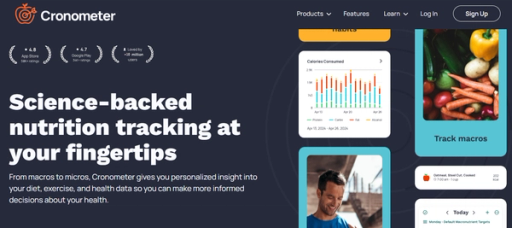
Nutrition is an essential aspect of our diet that helps prevent obesity and the risks associated with the comorbidities of being overweight.
The Cronometer calorie counter app is an excellent MyFitnessPal alternative with an extensive food database. It allows you to track macros more accurately than MyFitnessPal. This platform connects with popular health trackers like:
It offers seamless integration and tracking and provides meal options for various diets, including:
Users can import recipes and create custom meals, especially when certain meals aren’t in the public database. There’s also an option to track nutritional intake and create organized food diaries where breakfasts, lunches, snacks, and dinners can be logged and categorized.
Most features are available with a free membership, with the option to upgrade to a Cronometer Gold subscription.
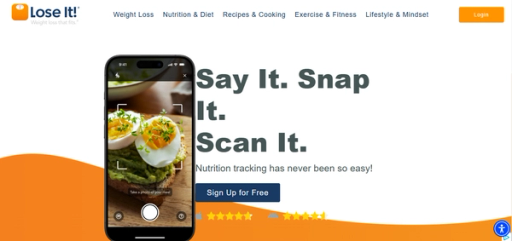
Lose It! is a calorie counter app designed for individuals looking to achieve fitness goals and lose weight by tracking their dietary choices.
This app provides a personalized journey with features like:
It also fosters social engagement through community forums where users can seek advice, share experiences, and find motivation.
Like MyFitnessPal, Lose It! offers exercise logging, calorie tracking, and goal-setting features to support your dieting journey and enhance weight loss results. It also includes exclusive features that MyFitnessPal lacks, such as:
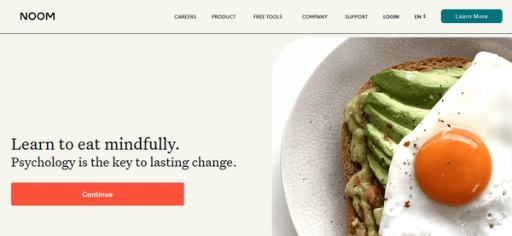
Noom is a weight management app that values psychological well-being when managing or losing weight. Rooted in psychological research, this app provides a holistic and mindful approach to dieting and exercise.
Users are encouraged to change their mindset around food upon using the app rather than eliminate specific food groups. This psychology-led platform promotes a healthier relationship with food based on cognitive behavioral therapy (CBT) methods. You can log and track your food intake through Noom’s exclusive food labeling system, which categorizes foods into three sections:
In addition to calorie tracking and food logging, you can track your exercise to maintain a workout routine. Users who purchase the premium subscription can access additional features, including:
Studies suggest that psychological state impacts food choices and vice-versa. For example, hereditary predisposition to anxiety or depression can contribute to overeating, while a healthy, balanced diet can improve mental well-being, reduce stress, and promote comfort.
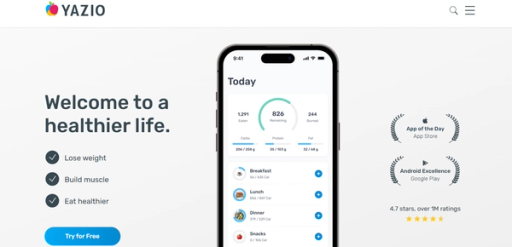
Yazio is a simple calorie counter app with multiple trackers to help users determine their daily calorie needs and stay within their budget.
It includes intermittent fasting plans and over 1,000 recipe options. With a food database, calorie tracking, and macronutrient tracking, Yazio is similar to MyFitnessPal. It offers extra features that outshine MyFitnessPal, such as:
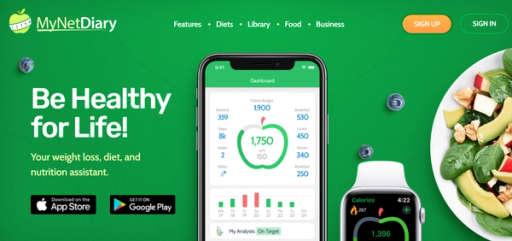
MyNetDiary is a nutrition and exercise tracking app for individuals committed to managing their weight and overall health.
With an intuitive barcode scanner, extensive food database, water intake tracking, easy meal tracking, and brilliant nutrient analysis, MyNetDiary is a compelling alternative to MyFitnessPal. It offers a comprehensive and personalized experience for sustainable weight management.
To help users stay on track, MyNetDiary features a calorie target tracker. This unique component uses an apple icon on the main screen to illustrate daily calorie goals:
The app includes a virtual coach that delivers professional nutritional advice for tailored support.

Nutracheck’s Calorie Counter+ is a calorie-counting food tracker designed to help individuals improve their diet and lose weight. The app tracks six key nutrients:
Upon logging food intake, users receive insightful nutrient analysis to underline their macronutrient and micronutrient consumption. Users can set customized goals, such as weight loss or muscle gain, which subsequently present tailored recommendations.
Calorie Counter+ integrates external activity tracking from accessories such as Fitbit and Apple HealthKit, allowing seamless and minimal-effort exercise monitoring.
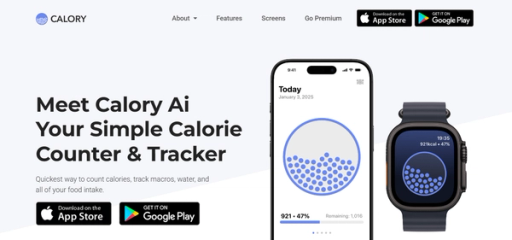
Calory is a calorie-tracking app Ilya Birman Design & Type developed that tracks how much you eat and how many calories you burn. Users enter their weight, height, exercise level, and desired weight loss, maintenance, or gain, and the app returns a daily calorie goal.
Calory is a simple and efficient way to track calorie intake. With Calory Premium, users can set daily targets for macronutrients, including:
The fluctuating calorie particles display daily progress, while weekly, monthly, and annual charts provide a snapshot of past performance.
Compatible with Apple Health, Calory records eating habits in an individual health record. It functions as a calorie tracker, calculator, and fluid intake monitor, helping users track daily water consumption.
Users can create unique meals, and Calory offers thousands of recipe ideas. The app also summarizes food notebook history through weekly, monthly, and yearly performance charts.
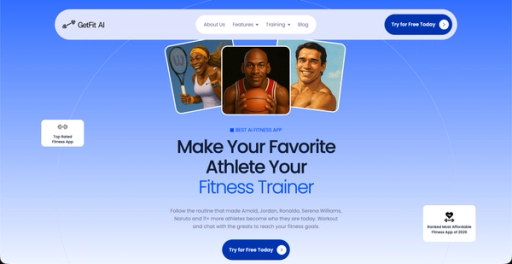
GetFit AI's AI fitness trainer app lets you follow the exact workout routines that made Arnold Schwarzenegger, Kobe Bryant, Cristiano Ronaldo, Serena Williams, and 11+ other elite athletes into champions. You can also chat with them whenever you need guidance or motivation.
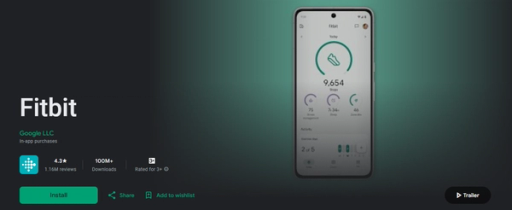
Fitbit is a powerful activity-tracking app that helps monitor calorie intake and nutrition with its barcode scanner. The paid version offers personalized coaching to help users stay in shape.
Key features:

MacroFactor uses “scientific algorithms to drive smart recommendations that fit your lifestyle.” Its clean and modern design makes navigation seamless. After you enter your body measurements and goals, the app will create a tailored program to support your progress.
Pricing: $71.99/year or $5.99/month

Elements such as features and overall functionality encompass the quality of a nutrition/weight loss app. A well-designed, high-quality app should feature essential components, including:
We recommend seeking an app that provides a seamless and intuitive user experience, ensuring elements such as progress monitoring, meal logging, and exercise tracking are easy to navigate.
The cost of weight loss and nutrition apps vary significantly. While many apps offer free versions, it’s worth acknowledging that premium subscriptions come with better resources and features that can help you better achieve your health and wellness goals.
Constantly assess which apps offer the most beneficial features for the price provided to determine if it’s worth your investment. Some apps offer free trials for a specific period, which can help you test whether the app’s features align with your weight loss goals and nutritional needs before committing.
The reputation of a health and fitness brand or app developer should continuously be assessed when deciding on a suitable weight loss or nutrition app. Established and reputable brands and developers are more likely to offer a pleasant user experience with reliable updates and bug fixes.
Reviewing an app’s customer feedback, awards, certifications, and news reports will help you gain a cohesive understanding of its reputation.
The effectiveness of a weight loss or nutrition app depends heavily on its features and approach. Ensuring that the app you choose is grounded in science and uses evidence-based features, such as nutrition tracking and analysis, will likely help you effectively achieve your weight loss and health goals.
You can determine the effectiveness of a weight loss or nutrition app by reviewing success stories/testimonials and researching who is behind the app, such as a nutritionist or dietitian.
One crucial aspect for users is the diversity and accuracy of food tracking options—most alternatives to MyFitnessPal feature extensive food databases. Nutritionix and Yazio boast large food libraries, allowing users to log meals from vast collections of foods and recipes.
Cronometer excels in its nutrient tracking capability, integrating Open Food Facts project data. This ensures detailed logging of micro and macro-nutrients, aiding users who need precise dietary management. FatSecret is known for its efficient food tracker and barcode scanner functionalities, making food logging quick and accurate.
MyNetDiary provides recipe import features, enabling users to track homemade meals easily. Users can also plan and log complex meals, making it suitable for those on specific diet plans. These features collectively ensure that users have thorough, accurate options for tracking their nutritional content effectively.
Diet and macro-management tools are essential for achieving health goals. For instance, FatSecret Professional provides detailed food tracking with dietary insights at no cost for the basic version. Apps like Nutracheck offer extensive food databases and barcode scanning, making it easier to log meals.
Waistline and Weight Tracker helps monitor progress over time, which is crucial for weight management and intermittent fasting. By tracking vitamins and suggesting food options, these apps cater to comprehensive nutritional needs.
Lifesum is a digital self-care app that offers personalized meal plans and fitness advice. These tools help users make informed dietary choices.
Calorie tracking can be tedious, especially if you do it manually. Fortunately, Cal AI is a revolutionary app that transforms calorie tracking with cutting-edge AI technology. Just snap a photo of your meal, and Cal AI does the rest. Cal AI combines your phone's depth sensor with advanced AI models to:
With 90 percent accuracy on visible foods and multiple tracking options, Cal AI makes nutrition tracking effortless. Gone are the days of tedious manual logging in calorie tracking apps. Whether scanning a full meal or a quick snack, Cal AI gives you accurate nutritional information in under 15 seconds.
The AI learns from your feedback, continuously improving its accuracy. Stay on track with personalized insights and brilliant reminders. Cal AI simplifies achieving your fitness goals. Track your calories with your camera using Cal AI's calorie tracker.